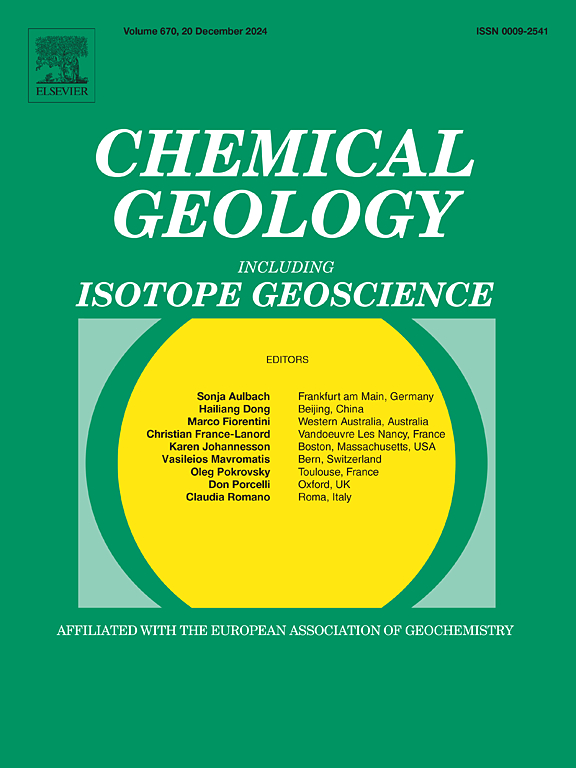滨海湿地互花米草碳硫耦合相互作用的理化性质和微生物介导途径调控
IF 3.6
2区 地球科学
Q1 GEOCHEMISTRY & GEOPHYSICS
引用次数: 0
摘要
互花米草入侵物种自几十年前引进以来,深刻地改变了中国沿海湿地的生物地球化学循环。研究了其对潮间带沉积物碳硫储量时空格局的影响。通过系统的野外采样和室内分析,定量分析了胶州湾湿地3个不同带的垂直沉积剖面的季节变化特征:互花沙藻入侵区(SAA)、原生蓝藻区(SGA)和无植被泥滩区(MA)。关键参数包括溶解有机碳(DOC)、土壤有机质(SOM)、总碳(TC)、4种无机硫形态(水溶性硫、吸附硫、盐酸可溶性硫、盐酸挥发性硫)和总硫(TS)。研究结果显示,与SGA和MA相比,SAA的DOC(16 - 107%)和TC(18 - 21%)浓度显著高于SGA和MA。SAA的TS积累量是其他两个地区的1.4 ~ 1.6倍,其中水溶性硫(17 ~ 32%)和盐酸挥发性硫(52 ~ 133%)的含量尤其高。值得注意的是,SAA冬季和夏季的SOM/TS比(28 - 37%)显著低于原生生态系统。这些结果表明互花草入侵通过碳硫耦合相互作用从根本上重构了海岸沉积物的地球化学,这对生物入侵下湿地的生物地球化学功能具有重要意义。本文章由计算机程序翻译,如有差异,请以英文原文为准。
Regulation of coupled carbon‑sulfur interactions by Spartina alterniflora via physicochemical properties and microorganism-mediated pathways in coastal wetlands
The invasive species Spartina alterniflora has profoundly altered biogeochemical cycling in coastal wetlands across China since its introduction decades ago. This study examined its impacts on spatiotemporal patterns of carbon and sulfur storage in intertidal sediments. Through systematic field sampling and laboratory analyses, we quantified seasonal variations in vertical sediment profiles across three distinct zones in Jiaozhou Bay wetlands: S. alterniflora-invaded area (SAA), native Suaeda glauca area (SGA), and unvegetated mudflat area (MA). Key parameters included dissolved organic carbon (DOC), soil organic matter (SOM), total carbon (TC), four inorganic sulfur forms (water soluble sulfur, adsorbed sulfur, hydrochloric acid soluble sulfur, hydrochloric acid volatile sulfur), and total sulfur (TS). Our findings revealed that SAA exhibited significantly higher DOC (16–107 %) and TC (18–21 %) concentrations compared to SGA and MA. TS accumulation in SAA surpassed the other two areas by 1.4- to 1.6-fold, with particularly large fractions of water-soluble sulfur (17–32 %) and hydrochloric acid volatile sulfur (52–133 %). Notably, SOM/TS ratios in SAA were significantly lower in winter and summer (28–37 %) than in native ecosystems. These results demonstrate that S. alterniflora invasion fundamentally restructures coastal sediment geochemistry through coupled carbon–sulfur interactions, with implications for wetland biogeochemical functioning under biological invasions.
求助全文
通过发布文献求助,成功后即可免费获取论文全文。
去求助
来源期刊

Chemical Geology
地学-地球化学与地球物理
CiteScore
7.20
自引率
10.30%
发文量
374
审稿时长
3.6 months
期刊介绍:
Chemical Geology is an international journal that publishes original research papers on isotopic and elemental geochemistry, geochronology and cosmochemistry.
The Journal focuses on chemical processes in igneous, metamorphic, and sedimentary petrology, low- and high-temperature aqueous solutions, biogeochemistry, the environment and cosmochemistry.
Papers that are field, experimentally, or computationally based are appropriate if they are of broad international interest. The Journal generally does not publish papers that are primarily of regional or local interest, or which are primarily focused on remediation and applied geochemistry.
The Journal also welcomes innovative papers dealing with significant analytical advances that are of wide interest in the community and extend significantly beyond the scope of what would be included in the methods section of a standard research paper.
 求助内容:
求助内容: 应助结果提醒方式:
应助结果提醒方式:


